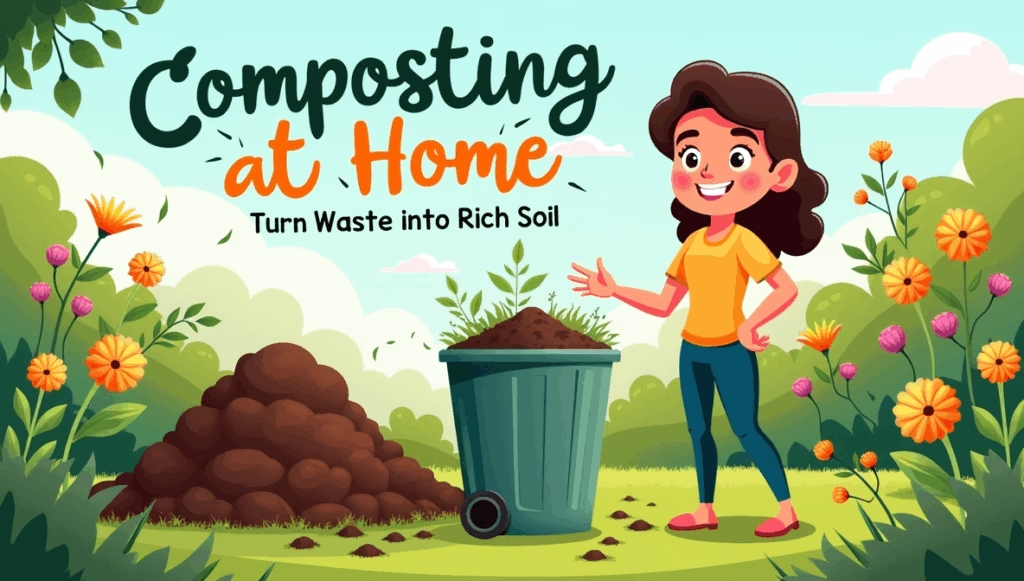Composting is one of the easiest and most eco-friendly ways to recycle kitchen and garden waste into valuable organic fertilizer. Instead of throwing away food scraps and dry leaves, you can convert them into rich compost that improves soil fertility and helps plants grow naturally.

Related Read: Best Compost for Terrace Gardening in India
In this guide, we’ll explain how to do composting at home step by step and turn everyday waste into nutrient-rich soil.
What is Composting?
Composting is a natural process where microorganisms break down organic waste such as fruit peels, vegetable scraps, dry leaves, and paper into a dark, nutrient-rich substance called compost. This acts as a natural fertilizer, improving soil structure and fertility.
For more details, you can refer to the Food and Agriculture Organization’s Composting Guide.
Benefits of Composting at Home
- Reduces kitchen and garden waste.
- Saves money on chemical fertilizers.
- Provides plants with organic nutrients.
- Improves soil health and water retention.
- Helps reduce carbon footprint and pollution.
Related Read: Onion Seeds for Terrace Gardening in India
Step-by-Step Composting at Home
Step 1: Choose a Compost Bin or Pit
You can start composting in a simple bucket, a clay pot, or a compost bin. For larger spaces, dig a pit in your backyard.
If you want inspiration, check out Swachh Bharat Mission’s Solid Waste Management Guidelines.
Step 2: Collect Green Waste
Green waste includes fruit peels, vegetable scraps, leftover food (without oil), tea leaves, and coffee grounds. These provide nitrogen.
Step 3: Collect Brown Waste
Brown waste includes dry leaves, sawdust, shredded paper, cardboard, and small twigs. These provide carbon and help balance moisture.
Step 4: Layer the Waste
Start with a layer of brown waste at the bottom, then add green waste. Keep alternating layers for best results.
Step 5: Maintain Moisture and Airflow
Sprinkle little water if the pile is too dry. Stir or turn the compost once a week to allow airflow. This prevents foul odor.
Step 6: Let it Decompose
Composting usually takes 6–8 weeks. The compost is ready when it becomes dark, crumbly, and smells like soil.
Step 7: Use Your Compost
Use the finished compost for terrace gardening, potted plants, or backyard soil to improve fertility.
What You Can and Cannot Compost
Things You Can Compost
- Fruit & vegetable peels
- Tea leaves and coffee grounds
- Dry leaves and grass clippings
- Shredded paper and cardboard
- Eggshells
Things You Should Avoid
- Oily or cooked food
- Meat and dairy products
- Plastic and synthetic waste
- Diseased plants
- Pet waste
For a more detailed breakdown, check EPA’s Composting Basics.
Tips for Faster Composting
- Chop waste into smaller pieces for quicker breakdown.
- Keep a proper balance of green (wet) and brown (dry) waste.
- Add a handful of soil or old compost to speed up decomposition.
- Maintain moderate moisture—neither too dry nor too wet.
Conclusion
Composting at home is simple, cost-effective, and sustainable. By following these steps, you can turn kitchen waste into rich compost and ensure healthier, organic growth for your plants. It not only reduces household waste but also helps create a greener environment.
Start today with Agzora’s Compost and Gardening Essentials and make your garden thrive naturally.
FAQs on Composting at Home
1. How long does composting take?
It usually takes 6–8 weeks, depending on the type of waste and weather conditions.
2. Does composting smell bad?
No, if done properly. Foul odor occurs only if too much wet waste is added or there is poor airflow.
3. Can compost be used for terrace gardening?
Yes, compost is the best natural fertilizer for terrace and balcony gardens.
4. Do I need a special bin for composting?
No, you can start composting in a bucket, pot, or pit with proper layering.
5. Is composting suitable for small apartments?
Yes, you can use compact compost bins or bokashi bins indoors without mess.





